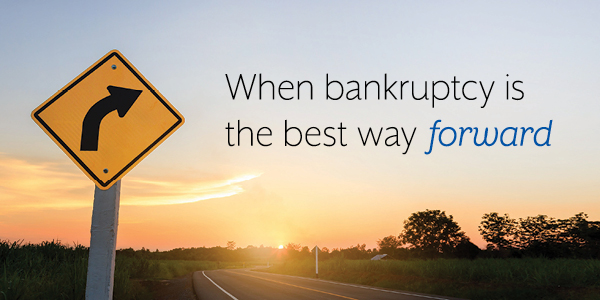As interest rates and debt levels rise, many individuals and small business owners are feeling the pinch. Most will make it through with some belt-tightening, but some may need to take further action.
As a last resort, a debt agreement or bankruptcy may be an option. But what are your obligations if you take this path and what will it mean for your tax position and life afterwards?
Solutions to financial pressure
There are many reasons consumers and businesses are finding it harder to pay their bills, with Australia’s pandemic closures, the recent spate of natural disasters, supply challenges and now an energy crisis piling on the pressure.
Figures from the Australian Financial Security Authority (AFSA) show in April 2022 there were 700 new personal insolvencies across the country, with the majority (61.4 per cent) being bankruptcies. Within these, 37.7 per cent were business-related bankruptcies.
But bankruptcy is not the only option. If you find yourself unable to pay your debts, you can also consider making a debt agreement, a personal insolvency agreement, or seeking temporary debt protection (TDP).
A TDP prevents creditors from seizing your assets or wages and gives you time to seek advice, while the other formal insolvency options (such as debt and personal insolvency agreements) are a longer-term answer for pressing financial problems.
Debt and declaring bankruptcy
The most well-known formal insolvency option is bankruptcy. This is a legal process where you are released from most of your debts and are able to make a fresh start with your finances.
In 2020-21, around 6,800 Australians declared bankruptcy. This represented a 46.7 per cent decline from the previous year but was largely due the special debt forgiveness rules in place due to COVID-19.
Although bankruptcy can sound great when you or your business are drowning in unpaid bills, it’s a serious step with significant implications. You should definitely speak to us or a financial counsellor to understand its consequences before taking any action.
Once you file for bankruptcy, a Trustee is appointed to manage your ‘bankrupt estate’ and dispose of assets to pay your debts. If you earn over a set amount during your bankruptcy, you may be required to make compulsory ‘contributions’ from your income to your Trustee.
Impact of bankruptcy
Bankruptcy has serious consequences. Your name will permanently appear on the National Personal Insolvency Index, which is likely to affect your ability to obtain credit in the future. When applying, you must inform any credit provider you are bankrupt and credit reporting agencies will keep a record of your bankruptcy for five years from the date you become bankrupt.
You are required to request written permission from your Trustee to travel overseas, even if it’s for work. Travelling without permission could extend your bankruptcy or result in a prison sentence.
Bankruptcy doesn’t stop you from working and normally the AFSA doesn’t inform your employer, but there are limitations when operating as a sole trader. Court permission is required to be a company director or manage a company.
Your Trustee may sell your assets to help repay your debts, although you are able to keep ordinary household goods, tools up to a set amount used to earn your income and vehicles valued under a threshold.
Recoverable debts
Once you are discharged from bankruptcy (which usually lasts for three years and one day), your creditors can’t recover any remaining pre-bankruptcy debts.
Bankruptcy doesn’t, however, release you from all your debts. If you have secured debts (such as a mortgage over your home), creditors have the right to take possession of your property even if you are in bankruptcy.
While most unsecured debts (such as credit cards, personal and pay day loans, utility bills and unpaid rent) are covered by bankruptcy, some debts must be paid. These include court-imposed penalties, child support and debts incurred after your bankruptcy starts.
You may also be required to repay student loans (such as HECS and Student Financial Supplement Scheme) in the same way as if you had not been declared bankrupt.
Tax and bankruptcy
If you declare bankruptcy or your creditors petition for it, your tax responsibilities don’t disappear either. You still need to lodge a tax return, and outstanding personal returns and Business Activity Statements must be filed.
The ATO ranks equally with other unsecured creditors, so if it’s one of your creditors, your Trustee will not necessarily pay this debt first. The only priority tax claims are unpaid Superannuation Guarantee Charge (SGC) debts if you have employees.
If your Trustee decides to sell some of your assets to clear your debts, this may create a capital gain or loss and the CGT event must be recorded in your annual tax return. The ATO may also offset any tax refunds you become entitled to against any tax, child support or family assistance debts.
If you are experiencing financial difficulties, please call us to discuss your options.
Running a business during bankruptcy
Adrian is a 36-year-old tradie who runs his own odd-jobs business and earns $40,000 a year.
Adrian and his young family rent an apartment. The van he uses for work is worth $6,000, while his work tools are valued at around $3,000.
Adrian is not the best recordkeeper when it comes to his business and in June 2022 he discovers he owes the ATO a $100,000 business-related debt. He also owes his bank $20,000 in credit card debt.
After speaking to his accountant, Adrian is referred to a Registered Trustee, who explains to Adrian bankruptcy will:
- Release him from his unsecured ATO and credit card debts.
- Allow him to keep his van and work tools as they are valued below the June 2022 asset threshold.
- Allow him to continue working as a sole trader. (He must, however, either tell people he is bankrupt, or change his business name to include his full name.)
- Not require him to make compulsory income payments as he earns under the current income threshold.
Source: Australian Financial Security Authority
Advice Centre is a collaboration of Lending Specialists (Lewis Consulting & Finance Pty Ltd ACN 650 030 274), Accountants (CLM Management Pty Ltd ACN 125 745 128) & Financial Planners (STB Wealth Pty Ltd ACN 614 239 799) – Creating Valuable Outcomes, Together.
STB Wealth Pty Ltd ACN 614 239 799 trading as Advice Centre (Corporate Authorised Representative #1250433) of Alliance Wealth Pty Ltd ABN 93 161 647 007 (Australian Financial Services Licence #449221.
This information has been provided as general advice. We have not considered your financial circumstances, needs or objectives. You should consider the appropriateness of the advice. You should obtain and consider the relevant Product Disclosure Statement (PDS) and seek the assistance of an authorised adviser before making any decision regarding any products or strategies mentioned in this communication.
Whilst all care has been taken in the preparation of this material, it is based on our understanding of current regulatory requirements and laws at the publication date. As these laws are subject to change you should talk to an authorised adviser for the most up-to-date information. No warranty is given in respect of the information provided and accordingly neither Alliance Wealth Pty Ltd nor its related entities, employees or representatives accepts responsibility for any loss suffered by any person arising from reliance on this information.

